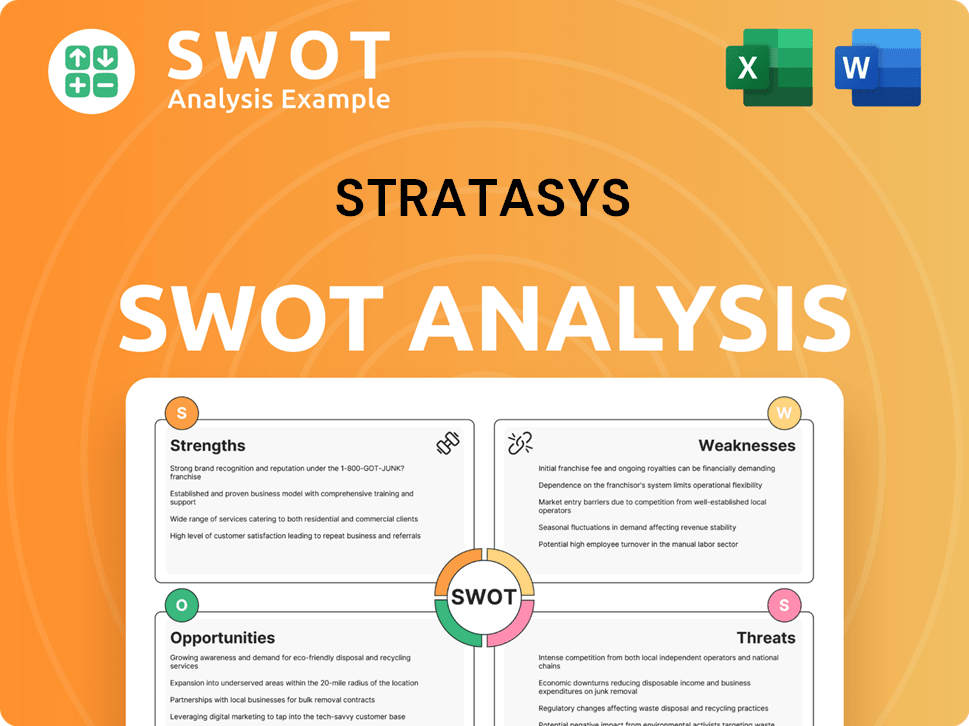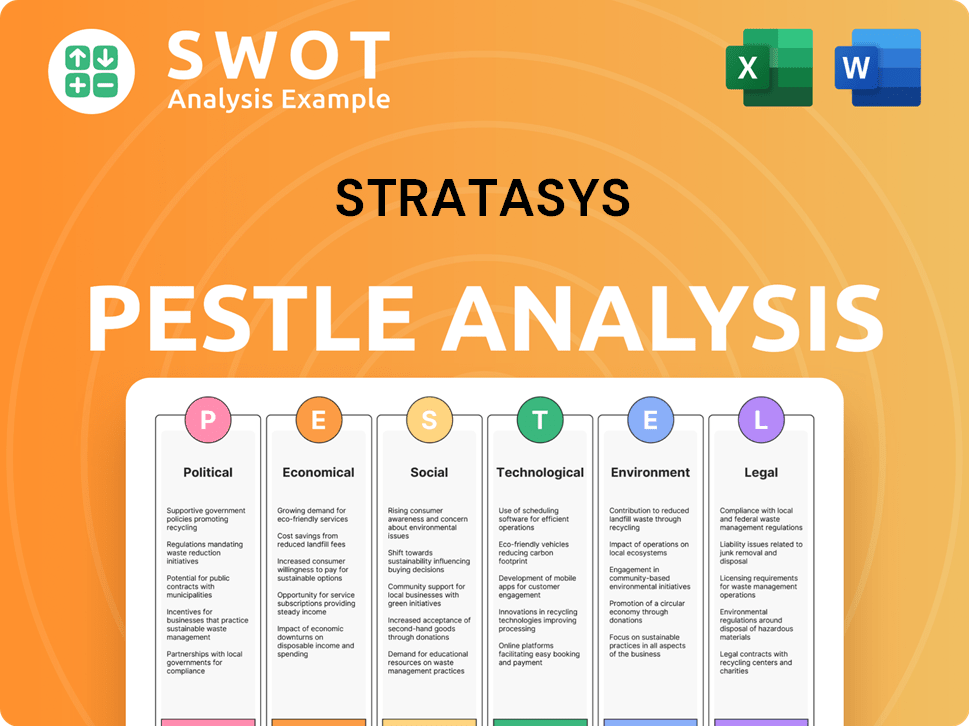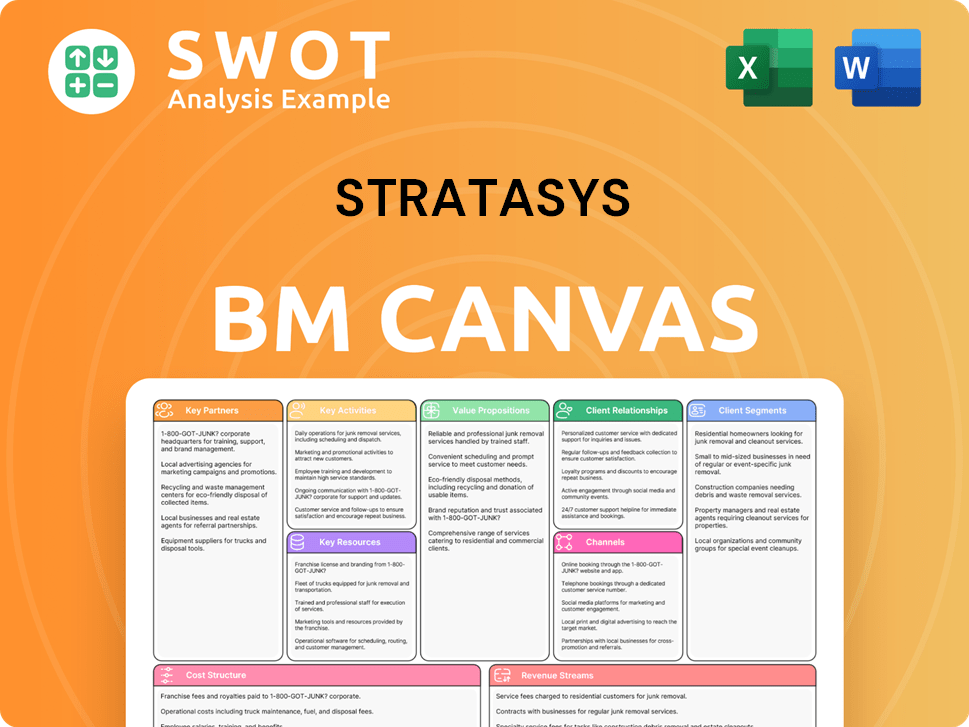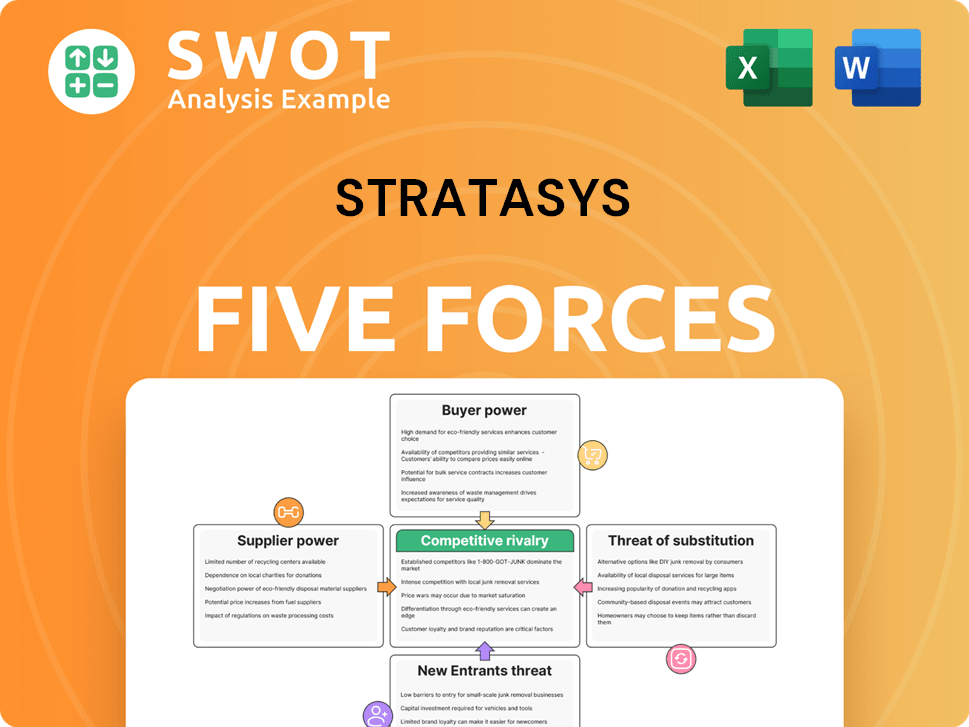Stratasys Bundle
How Does Stratasys Stack Up in the 3D Printing Arena?
The 3D printing industry is booming, transforming how products are designed and manufactured across various sectors. Stratasys SWOT Analysis offers a deep dive into this dynamic market, exploring the company's position within it. Founded in 1989, Stratasys has been a key player, but who are its biggest rivals, and how is it navigating the competitive landscape?

This analysis provides a comprehensive look at the Stratasys competitive landscape, examining its key Stratasys competitors and the broader 3D printing industry trends shaping its future. We'll dissect Stratasys market analysis to understand its Stratasys market share and strategic responses to emerging challenges. Gain insights into Stratasys's strengths and weaknesses analysis, and how it compares to other major players. Ultimately, we'll explore the future of Stratasys in the 3D printing market.
Where Does Stratasys’ Stand in the Current Market?
The company holds a significant position within the 3D printing industry, specifically in the professional and industrial sectors. A Stratasys market analysis reveals a strong presence in polymer 3D printing, offering technologies like FDM, PolyJet, and SLA. Its products serve diverse applications, including prototyping, tooling, and end-use parts, catering to industries such as aerospace, automotive, and healthcare.
Geographically, the company has a global footprint, with sales and support networks across North America, Europe, and Asia. This broad reach allows it to serve a wide array of customers. The company's strategic focus has shifted towards industrial production, aiming to integrate additive manufacturing into mainstream production workflows, moving beyond its traditional prototyping stronghold.
The company reported revenue of approximately $144.3 million in Q1 2024, with a gross margin of 44.9% for the same period. The Stratasys competitive landscape is influenced by ongoing pressures, and the company aims to strengthen its position in key vertical markets through integrated solutions. The company's financial health indicates a stable revenue base and ongoing investments in R&D to maintain its technological edge.
The company consistently ranks among the top players in the global 3D printing market. While specific market share figures fluctuate and are reported by segment, the company maintains a strong presence. The company's focus on industrial production applications, along with its diverse technology portfolio, supports its market position.
- The company's revenue in Q1 2024 was approximately $144.3 million.
- Gross margin for Q1 2024 was 44.9%.
- The company's global presence includes North America, Europe, and Asia.
- The company offers FDM, PolyJet, and SLA technologies.
Stratasys SWOT Analysis
- Complete SWOT Breakdown
- Fully Customizable
- Editable in Excel & Word
- Professional Formatting
- Investor-Ready Format

Who Are the Main Competitors Challenging Stratasys?
The 3D printing industry, also known as additive manufacturing, is highly competitive, with several players vying for market share. The Stratasys competitive landscape is shaped by both direct and indirect rivals, each employing different strategies to capture a portion of the market. Understanding the competitive dynamics is crucial for investors and stakeholders interested in the Stratasys market analysis and its future prospects.
Stratasys competitors include established industry leaders and emerging companies, each bringing unique technologies and market approaches. These competitors challenge Stratasys through innovation, pricing, and strategic partnerships. The competitive environment is constantly evolving, influenced by technological advancements, mergers, and acquisitions, making it essential to stay informed about the latest developments in the 3D printing industry.
Direct competitors offer similar technologies and target the same markets as Stratasys. These companies compete directly on product offerings, pricing, and market reach.
Indirect competitors may offer different technologies or target different segments of the 3D printing market. They still impact Stratasys's overall market position.
The Stratasys market share is influenced by the performance of its competitors. Analyzing market share trends provides insights into the competitive landscape's evolution.
Technological advancements are a key factor in the 3D printing industry. Competitors continuously introduce new technologies, materials, and features.
Strategic alliances and collaborations help companies expand their market reach and access new technologies or distribution channels. These partnerships can significantly impact the competitive landscape.
Assessing the financial performance of Stratasys and its competitors provides insights into their market positions and growth potential. Revenue, profitability, and investment in R&D are key indicators.
Several companies pose significant challenges to Stratasys. These competitors employ various strategies to gain market share, including technological innovation, strategic partnerships, and competitive pricing. Understanding these strategies is essential for a comprehensive Stratasys competitor analysis report.
- 3D Systems: A direct competitor, 3D Systems offers a range of technologies similar to Stratasys, including SLA, FDM, and SLS. They target similar industrial and professional markets. In 2024, 3D Systems reported revenue of approximately $600 million, reflecting its strong presence in the 3D printing industry.
- HP Inc.: HP has made significant inroads with its Multi Jet Fusion (MJF) technology, particularly in production-oriented applications. HP challenges Stratasys in the manufacturing segment with its speed and cost-effectiveness. HP's 3D printing business has shown steady growth, with revenues exceeding $400 million in 2024.
- EOS GmbH: EOS specializes in high-end industrial 3D printing systems for metals and polymers. They focus on demanding industrial applications where precision and material properties are critical. EOS's strong focus on industrial applications has allowed it to maintain a significant market share, with revenues estimated to be around $450 million in 2024.
- Carbon: Carbon's Digital Light Synthesis (DLS) technology offers high-speed polymer 3D printing for end-use parts. They often target specific industries like consumer goods and dental. Carbon's innovative approach has led to rapid growth, with revenues projected to reach $200 million in 2024.
- Formlabs: Formlabs focuses on the professional desktop market and continues to innovate and expand its offerings, potentially impacting Stratasys's entry-level industrial solutions. Formlabs's focus on accessible, high-quality 3D printing has made it a strong competitor, with revenues of approximately $150 million in 2024.
The competitive landscape is further shaped by mergers and alliances. For example, the ongoing discussions and attempts at consolidation within the industry, such as the past acquisition bids involving Stratasys, highlight the intense competitive dynamics and the pursuit of strategic advantages through scale and technological breadth. To learn more about the strategies, check the Marketing Strategy of Stratasys.
Stratasys PESTLE Analysis
- Covers All 6 PESTLE Categories
- No Research Needed – Save Hours of Work
- Built by Experts, Trusted by Consultants
- Instant Download, Ready to Use
- 100% Editable, Fully Customizable

What Gives Stratasys a Competitive Edge Over Its Rivals?
Analyzing the Stratasys competitive landscape reveals several key strengths that position it prominently within the 3D printing industry. Their focus on proprietary technologies, including Fused Deposition Modeling (FDM) and PolyJet, gives them a significant edge. These technologies cater to a wide range of applications, from functional prototypes to end-use parts, across various sectors.
Stratasys market analysis indicates a strong brand reputation and a well-established global network. This network supports customers with everything from initial sales to ongoing maintenance, which is crucial in the industrial additive manufacturing sector. Their deep application expertise and collaborative approach further enhance their value proposition.
However, the Stratasys competitive landscape is dynamic, with rivals constantly innovating. To maintain its edge, Stratasys invests heavily in research and development and forms strategic partnerships. Understanding these competitive advantages is essential for anyone looking into the 3D printing industry.
Stratasys holds a substantial portfolio of patents, particularly related to FDM and PolyJet technologies. These technologies offer unique material capabilities and system performance. This protects them from direct replication by competitors and allows them to offer differentiated products.
The company benefits from a strong brand reputation built over years of experience. Their global distribution and service network provides comprehensive customer support. This extensive network helps ensure customer satisfaction and loyalty.
Stratasys works closely with customers to develop tailored solutions. This collaborative approach allows them to address specific manufacturing challenges. This focus on customer needs enhances their market position.
They are focused on developing a broad ecosystem of hardware, software, and materials. This comprehensive approach enhances the value proposition for its customers. This ecosystem approach provides a competitive advantage.
Stratasys's competitive advantages include its proprietary technologies, strong brand recognition, and extensive global network. These factors allow the company to maintain a strong position in the 3D printing industry. Their focus on customer-specific solutions and ecosystem development further strengthens their market position.
- Proprietary Technologies: FDM and PolyJet offer unique capabilities.
- Strong Brand: Long history and reputation for reliability.
- Global Network: Comprehensive support from sales to maintenance.
- Application Expertise: Tailored solutions for various industries.
- Ecosystem Approach: Integrated hardware, software, and materials.
Stratasys Business Model Canvas
- Complete 9-Block Business Model Canvas
- Effortlessly Communicate Your Business Strategy
- Investor-Ready BMC Format
- 100% Editable and Customizable
- Clear and Structured Layout

What Industry Trends Are Reshaping Stratasys’s Competitive Landscape?
The 3D printing industry, also known as additive manufacturing, is experiencing significant shifts, creating both challenges and opportunities for companies like Stratasys. This dynamic environment is influenced by technological advancements, evolving market demands, and the emergence of new competitors. Understanding the Stratasys competitive landscape is crucial for investors and stakeholders aiming to make informed decisions in this rapidly evolving sector.
The Stratasys market analysis reveals a complex interplay of factors. While the company benefits from its established position and technological expertise, it must navigate increasing competition and the need for continuous innovation. The future outlook for Stratasys depends on its ability to adapt, innovate, and capitalize on emerging trends in the 3D printing industry.
Key trends include faster printing speeds, larger build volumes, and the use of advanced materials, including polymers and composites. Industry 4.0 and digital manufacturing integration are also becoming increasingly important. Regulatory changes, particularly concerning material certifications, will continue to shape the market.
Increasing commoditization of certain 3D printing technologies and the rise of lower-cost competitors, especially from Asia, pose a challenge. The shift towards industrial production requires higher reliability, repeatability, and cost-effectiveness. The need for continuous R&D investment remains critical.
The expanding market for end-use parts across industries like automotive, aerospace, and medical offers significant growth potential. Demand for customized products and on-demand manufacturing favors additive manufacturing. Strategic partnerships and acquisitions can broaden technological capabilities.
Stratasys's strategy likely involves continued investment in advanced materials, software for workflow integration, and targeted acquisitions. The goal is to solidify its position as a key enabler of industrial additive manufacturing. This approach aims to maintain a competitive edge in the evolving market.
The Stratasys competitors landscape includes established players and emerging companies. Key rivals include 3D Systems, HP, and various Asian manufacturers. Market dynamics are influenced by technological advancements, pricing strategies, and the ability to serve diverse industry needs. Understanding the competitive landscape is essential for assessing Stratasys market share and future performance.
- 3D Systems: A major competitor with a broad portfolio of 3D printing solutions.
- HP: Offers Multi Jet Fusion technology, competing in the industrial sector.
- Emerging Asian Manufacturers: Provide lower-cost solutions, increasing competitive pressure.
- Material Suppliers: Companies that provide materials for 3D printing, influencing the market.
To gain deeper insights into the company's financial health and strategic direction, consider exploring the insights provided at Owners & Shareholders of Stratasys. This analysis can assist in understanding the competitive positioning and future prospects of Stratasys.
Stratasys Porter's Five Forces Analysis
- Covers All 5 Competitive Forces in Detail
- Structured for Consultants, Students, and Founders
- 100% Editable in Microsoft Word & Excel
- Instant Digital Download – Use Immediately
- Compatible with Mac & PC – Fully Unlocked

Related Blogs
- What are Mission Vision & Core Values of Stratasys Company?
- What is Growth Strategy and Future Prospects of Stratasys Company?
- How Does Stratasys Company Work?
- What is Sales and Marketing Strategy of Stratasys Company?
- What is Brief History of Stratasys Company?
- Who Owns Stratasys Company?
- What is Customer Demographics and Target Market of Stratasys Company?
Disclaimer
All information, articles, and product details provided on this website are for general informational and educational purposes only. We do not claim any ownership over, nor do we intend to infringe upon, any trademarks, copyrights, logos, brand names, or other intellectual property mentioned or depicted on this site. Such intellectual property remains the property of its respective owners, and any references here are made solely for identification or informational purposes, without implying any affiliation, endorsement, or partnership.
We make no representations or warranties, express or implied, regarding the accuracy, completeness, or suitability of any content or products presented. Nothing on this website should be construed as legal, tax, investment, financial, medical, or other professional advice. In addition, no part of this site—including articles or product references—constitutes a solicitation, recommendation, endorsement, advertisement, or offer to buy or sell any securities, franchises, or other financial instruments, particularly in jurisdictions where such activity would be unlawful.
All content is of a general nature and may not address the specific circumstances of any individual or entity. It is not a substitute for professional advice or services. Any actions you take based on the information provided here are strictly at your own risk. You accept full responsibility for any decisions or outcomes arising from your use of this website and agree to release us from any liability in connection with your use of, or reliance upon, the content or products found herein.